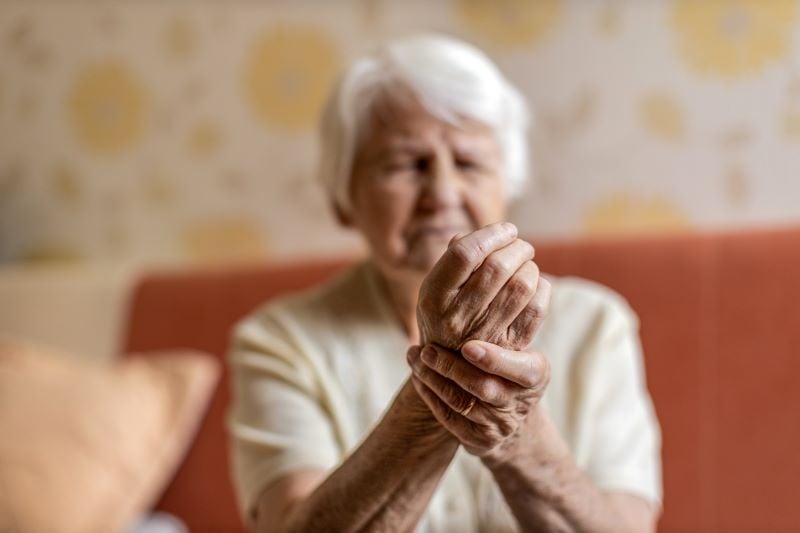Introduction
Osteoarthritis (OA) is sometimes referred to as a wear and tear disease. It is a very common issue with older people and many people think that osteoarthritis is an inevitable consequence of aging.
But is it?
Keep reading to see what the experts say about the risk factors, symptoms, diagnosis and treatment of osteoarthritis.
But remember – while the discussion draws on current professional and research literature, it is intended to provide general information not advice. If you, or someone you know is seeking advice or support regarding managing osteoarthritis, you should seek expert professional help.
What is Osteoarthritis?
Osteoarthritis affects joints and can affect any joint of your body. Joints are those parts of your skeleton where two or more bones meet. Joints provide stability to your skeleton while enabling you to move freely and flexibly.
In healthy joints the ends of the bones are cushioned by a layer of cartilage. This firm, slippery tissue enables the joint bones to move smoothly past each other without rubbing and causing undue friction.
If you develop osteoarthritis, the joint cartilage in your affected joints becomes worn and/or damaged and your joint loses its ability to move smoothly. Eventually, bones may rub against each other as you move your joints and this causes inflammation, pain and stiffness and rigidity.
OA can affect any part of your body,, but most commonly affects knees, hips, hands, fingers, neck and lower back.
Is OA the same as Rheumatoid arthritis?
People sometimes confuse osteoarthritis and rheumatoid arthritis. While they have similar symptoms, they are very different conditions. The main difference between the two is the underlying cause. Osteoarthritis a degenerative joint disease caused by mechanical wear and tear and injuries to the joints. Rheumatoid arthritis is an autoimmune disorder where the body’s immune system attacks joint tissues.
Who gets it?

Osteoarthritis (OA) is the most common form of arthritis. It affects millions of people worldwide and is the most common form of arthritis in Australia, affecting 1 in 5 Australians over age 45 and 1 in 3 over age 75 (Arthritis Australia, 2024).
These figures seem to support the view that as we age, our joints wear out and no longer function effectively – osteoarthritis is an inevitable part of aging. Thus the reference to OA as a wear and tear disease. However this perception is not accurate.
While osteoarthritis symptoms develop more frequently in people over age 50, the condition can emerge at any age, particularly in those who have had a prior joint injury.
The message: Osteoarthritis is not an inevitable consequence of ageing. Not all older people develop the condition while younger people may also develop OA. Risk factors for developing the condition are relevant at any age.
Osteoarthritis Risk Factors
Evidence suggests that anything that directly impacts or damages our joints can be a risk factor for developing osteoarthritis. A number of current risk factors have been identified. These include:
Age: the risk does increase as we grow older.
Genetics: If we have family members, particularly close members such as parents or siblings, we have a higher risk of developing the condition.
Sex: Women, particularly post-menopausal women, are more likely to develop osteoarthritis than men and some research (Hussein et al., 2018) suggests that hormonal differences may play a role in the development of osteoarthritis.
Obesity: Extra body weight increases pressure on weight-bearing joints such as knees and hip joints. In addition, fat tissue produces proteins that can cause inflammation in and around the joints.
Overuse or Repetitive movements: performing repetitive actions (for example kneeling, climbing, or heavy lifting) in work or recreation places stress on joints. Over time this can result in OA developing.
Joint injury: bone fractures, dislocations and cartilage or ligament tears can increase the risk of osteoarthritis. This includes injuries that occurred many years ago.
Muscle weakness: OA can develop if muscles don’t provide adequate joint support.
Medical conditions: Risks of developing osteoarthritis can arise from having metabolic diseases such as diabetes or from having a different type of arthritis. Having OA in one part of your body also increases your risk of developing it in other parts of your body.
Symptoms of osteoarthritis
The initial symptoms of osteoarthritis can be quite mild but may worsen over time. In the early stages you may only notice symptoms when moving. As the condition progresses, you may notice symptoms when you are less active or even if you are not moving.

Common symptoms.
Commonly reported symptoms include:
Painful joint: Initially, affected joints might be painful during or after movement – particularly after a long and repetitive activity or at the end of the day. In the later stages of the disease, the pain may be more frequent or constant.
Joint stiffness: Joint stiffness usually occurs first thing in the morning or after a period of inactivity.
Swelling: Swelling can be evident in and around the joint.
Other Symptoms and Signs
Loss of flexibility and decreased range of motion: This results in the inability to move the joint through its normal range.
Joint instability or feeling that the joint is loose or unstable
Clicking or popping sound when a joint bends
Bone spurs: extra lumps of bone that form around the affected joint. These are generally painless, but you may feel a grating sensation when using the joint.
In the early stages these symptoms are usually worse during or after physical activity. As OA develops they can become more constant. They may ultimately affect our ability to do normal daily activities, such as walking, climbing stairs and opening jars.
Diagnosis
As the condition often develops slowly, it can be hard to diagnose osteoarthritis until it starts to cause significant pain or debilitating symptoms.
A consultation with a health care provider is often the first step in diagnosing osteoarthritis. The consult may include a review of your medical history and current symptoms, and a physical examination of the joints. Initial consultations may also involve referral for additional tests and imaging such as X-rays and MRI (Magnetic resonance imaging). A blood test can eliminate other conditions that cause joint pain, such as rheumatoid arthritis. X-rays can show joint damage or changes related to osteoarthritis while an MRI uses radio waves and a magnetic field to create images of bone and soft tissue. Once a diagnosis is made, a management/treatment plan can be developed and implemented. A range of health professionals can be involved in this process.
Outlook/Treatment
Osteoarthritis is a chronic condition for which there is no cure. However an effective management plan can help minimize joint pain and enable you to remain active and mobile.Therefore, the focus of an effective OA plan is on symptom management. Strategies to manage osteoarthritis symptoms encompass measures such as staying active, maintaining a healthy weight, using supportive devices, pain management and medication and, sometimes viewed as a last resort, joint surgery (Arthritis Australia).
Consult a Health Professional
Health professionals have the knowledge and experience to develop and monitor individualized management plans.
It is important that clients be informed about their condition and have some understanding of the management strategies being recommended. A plan is more effective when the client takes an active role in the development and implementation process.
Regular exercise
Regular exercise is one of the most effective strategies for managing osteoarthritis. Exercise can reduce pain and relieve stiffness, strengthen muscles around joints, and help maintain joint flexibility. Exercise also helps prevent other health problems. Professional advice (Arthritis Australia, 2024, HealthLine, 2024) suggests that exercise programs include:
Aerobic exercise is good for heart and lung health, while improving general fitness and overall energy levels. It is recommended that activities be low impact to minimize repetitive stress on joints. Examples of aerobic activities include swimming, water aerobics or cycling. Daily walks and physically active hobbies such as gardening and looking after pets can also contribute to aerobic fitness levels.
Strengthening exercises build and strengthen muscles around painful joints. Using weights and resistance bands can improve muscle and bone strength, while taking pressure off joints
Gentle stretching helps to reduce joint pain and stiffness while maintaining or improving flexibility. Yoga and Tai Chi are helpful for developing and maintaining flexibility,
Balance exercises: Research indicates people with OA are more at risk of falls than those without (Arthritis Foundation, 2024). Including balance exercises helps strengthen the small muscles around the knees and ankles and help prevent falls.
Weight management
Excess weight gain can increase pain and put additional stress on weight-bearing joints such as hips, knees, ankles, feet and back. In addition, fat tissue produces substances that can cause joint inflammation. Losing weight can reduce pain and slow joint damage. A combination of healthy eating with a regular exercise program can help to maintain a healthy weight.
Pain management
Options for osteoarthritis pain management include medication, complementary medicine and therapies.
Medications
A number of different types of OA medications can help provide pain relief and reduce swelling. These include over the counter paracetamol and nonsteroidal anti-inflammatory drugs (NSAIDs), prescription medications and topical pain relievers in the form of creams, gels, and patches. Some medications have potential side effects so it is important to seek the advice of a health professional when considering medication.
Complementary Therapy
Alternative treatments and supplements may help to relieve inflammation and joint pain. Many people find therapies such as acupuncture, massage, meditation and Tai Chi, helpful. At the same time, it is noted that what works for one person may not work for another. It may be necessary to try different techniques and therapies until you find what works best for you.
Assistive Devices
The many assistive devices currently available can help those with osteoarthritis to maintain a good quality of life. These products help support joints, provide leverage when needed and extend your range of motion.
A health professional can provide expert advice about using many aids or assistive devices available.
Joint surgery
If OA symptoms are no longer controlled with other therapies, joint replacement surgery may be considered. This surgery replaces damaged joints to restore mobility and relieve pain. Knee and hip joints are the most commonly replaced. If surgery is being considered, an orthopaedic surgeon will be consulted.
Summary
While some may perceive osteoarthritis as an inevitable consequence of aging, evidence suggests that anything that directly impacts on, or damages our joints can be a risk factor for developing osteoarthritis. The condition can emerge at any age, particularly in those who have had a prior joint injury.
While there is no cure for OA, an effective management plan will help minimise joint pain and enable individuals to maintain a good quality of life. The focus of an effective plan is therefore symptom management. Strategies to manage symptoms encompass lifestyle measures such as staying active, maintaining a healthy weight, using supportive devices, pain management and medication and surgery.
Health professionals have the knowledge and experience to develop and monitor individualised management plans while clients are encouraged to take an active role in the planning and implementation process.
References
- Arthritis Australia (2024), Osteoarthritis https://arthritisaustralia.com.au/types-of-arthritis/osteoarthritis/
- Heathdirect (2024), Osteoarthritis https://www.healthdirect.gov.au/osteoarthritis
- Healthline (2024) Everything You Need To Know About Osteoarthritis, https://www.healthline.com/health/osteoarthritis
- Hussain, S. M., Cicuttini, F. M., Alyousef, B., & Wang, Y. (2018). Female hormonal factors and osteoarthritis of the knee, hip and hand: a narrative review. Climacteric, 21(2), 132-139. https://doi.org/10.1080/13697137.2017.1421926
- Mayo Clinic (2024), Osteoporosis, https://www.mayoclinic.org/diseases-conditions/osteoarthritis/symptoms-causes/syc-20351925






